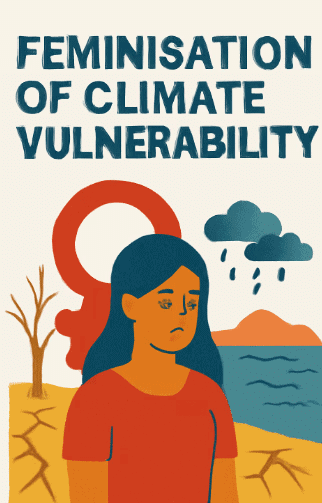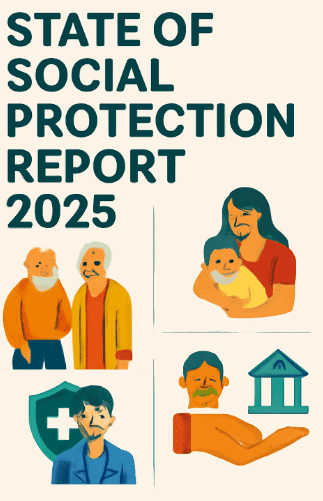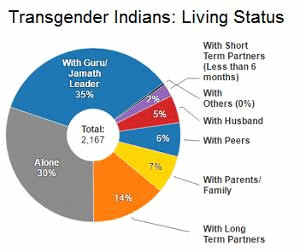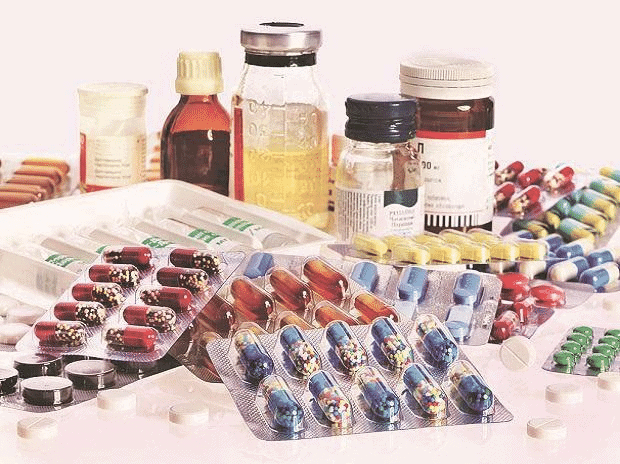Indian Society and Social Issues: April 2025 Current Affairs | Current Affairs & General Knowledge - CLAT PDF Download
Feminisation of Climate Vulnerability

Why in News?
The Beijing India Report 2024, released to mark three decades since the Beijing Declaration and Platform for Action (1995), reviews India's progress on gender equality. However, it offers limited insights into the critical link between gender inequality and climate change, particularly impacting women in rural and climate-vulnerable areas.
Key Takeaways
- The intersection of gender inequality and climate change is increasingly relevant.
- Climate change disproportionately affects women, particularly in rural settings.
- Women are primarily responsible for water collection, facing increased workloads due to climate-induced water scarcity.
Additional Details
- Gender Burden of Water Scarcity: Women and girls are responsible for water collection in 80% of households globally. Climate change exacerbates water scarcity, forcing them to travel longer distances, thus limiting their time for education and income-generating activities.
- The WHO reports that 2 billion people rely on contaminated water, posing significant health risks for women and girls, who collectively spend around 150 million workdays annually collecting water.
- Impact on Health and Well-being: Climate-induced events such as droughts lead to increased malnutrition among women. Food-insecure women are 1.6 times more likely to suffer from anemia. Additionally, extreme heat is linked to higher stillbirth rates and the spread of diseases, worsening maternal and neonatal health.
- Economic Impact: Extreme weather reduces agricultural productivity, resulting in income loss, particularly for women engaged in agriculture. Women’s unpaid care work is projected to rise due to climate-induced resource scarcity, deepening gender inequality.
- Migration and Displacement: Rural women face heightened vulnerability to climate-induced migration due to adverse weather conditions, leading to health issues and increasing their risk of exploitation and gender-based violence.
Addressing gender inequality in the context of climate change requires a multi-faceted approach. By focusing on gender-responsive climate policies and empowering women at the grassroots level, India can build a more resilient, sustainable, and equitable future.
State of Social Protection Report 2025

Introduction
The State of Social Protection Report 2025, released by the World Bank in April 2025, presents a detailed global review of social protection systems in 186 low- and middle-income countries (LMICs). The report identifies the "2-Billion-Person Challenge", highlighting the need for improved social protection for two billion people in LMICs who are either completely uncovered or inadequately protected, particularly in fragile and poverty-prone areas.
The report, based on the World Bank’s ASPIRE database, examines trends in coverage, adequacy, and public spending on social protection, aligning with Sustainable Development Goal (SDG) 1.3. This goal calls for the establishment of universal, inclusive, and shock-responsive social protection systems.
What is Social Protection?
- Social protection consists of public measures designed to safeguard individuals and families from economic and social hardships, ensuring a basic level of well-being throughout their lives.
- It is built on three core pillars:
- Social Assistance: This includes programs like cash transfers and food aid aimed at providing immediate support to those in need.
- Social Insurance: This covers programs such as pensions and health insurance that protect individuals against future risks.
- Labor Market Programs: These include skills training and public employment services that help individuals secure and maintain employment.
- Social protection systems play a crucial role in helping people escape poverty, manage life transitions and shocks, and take advantage of new employment opportunities.
- These systems also have a significant positive impact on local economies. For instance, every dollar given to poor households can generate up to $2.50 in increased economic activity, contributing to poverty reduction and inclusive growth.
Key Findings from the 2025 Report
- Historic High in Coverage: Social protection coverage has significantly increased to 4.7 billion people in LMICs, rising from 41% in 2010 to 51% in 2022, with the most substantial improvements among the poor in low-income countries (LICs).
- Ongoing Exclusion: Despite progress, 2 billion people in LMICs remain either uncovered or inadequately protected, including 1.6 billion without any benefits and 400 million receiving insufficient support.
- Concentration of Uncovered Populations: Uncovered individuals are primarily found in fragile, conflict-affected, and hunger-prone areas, particularly in South Asia, the Middle East, and Sub-Saharan Africa.
- Slow Progress in Coverage: Current trends indicate it will take 18 years to fully cover those living in extreme poverty and 20 years to cover the poorest 20% of households in LMICs.
- Disparities Across Income Groups: Coverage varies significantly by income group, with over 80% of people in LICs lacking coverage, 58% in lower-middle-income countries (LMICs), and around 11% in upper-middle-income countries (UMICs) being entirely excluded.
- Expansion Driven by Social Assistance: Social assistance, particularly cash transfers and school feeding programs, has been the main driver of expansion, especially in LICs. However, benefit adequacy remains low, covering only 11% of poor household income in LICs.
- Unequal Social Protection Spending: Spending on social protection varies widely, with LICs spending less than 2% of GDP, LMICs at 3.7%, and UMICs exceeding 6%.
- COVID-19 Pandemic as a Stress Test: The pandemic highlighted the importance of robust social protection systems, with emergency responses reaching 1.7 billion people, showing that countries with strong pre-existing systems were better equipped to scale up support.
- Gender Inequality in Social Protection: In a sample of 27 countries, women received only $0.81 for every dollar transferred to men, despite higher overall female enrollment in programs.
- Underutilization of Labor Market Programs: Labor market programs, which have the potential to improve employment, earnings, and productivity, reach only 5% of the population on average. These programs, including public works, job placement services, and unemployment insurance, are constrained by low global funding, with average spending at just 0.25% of GDP.
India’s Position – Progress and Gaps
- India has made significant strides in expanding social protection, with coverage increasing from 24.4% in 2021 to 48.8% in 2024. Currently, nearly 65% of the population receives at least one form of benefit, either cash or in-kind.
- However, over 90% of India’s workforce remains employed in the informal sector, and only 22% of informal workers are covered by any structured social protection scheme.
- There are substantial regional disparities in social protection coverage. States like Tamil Nadu and Kerala have relatively comprehensive systems, while Bihar, Uttar Pradesh, and certain areas in the East face significant gaps in delivery and coverage.
- Major initiatives such as eShram (with 30.68 crore registrations ), Atal Pension Yojana (with 7.25 crore subscribers ), Ayushman Bharat, PM-SYM, and PMGKAY have contributed to expanding coverage. However, there are issues with overlapping schemes, particularly between Ayushman Bharat and state-run health initiatives, leading to confusion among beneficiaries.
- The social welfare framework in India is hindered by fragmentation, with various schemes managed by different departments. This results in inefficiencies, duplication of efforts, and challenges in accessing benefits.
- The lack of a unified worker registry poses difficulties in identifying beneficiaries, leading to both inclusion and exclusion errors. Many eligible individuals are unaware of their entitlements due to inadequate outreach efforts.
- Gender disparities, especially in rural and informal contexts, limit women's access to digital platforms and benefit delivery, exacerbating their economic vulnerability.
- Portability issues prevent interstate migrant workers from accessing benefits, as current systems are not fully compatible across state lines.
- While social sector spending constituted about 21% of the Union Budget for much of the past decade, recent stagnation in allocations raises concerns about underinvestment in essential welfare infrastructure. The share has declined to 17% in 2024-25 and is projected to be 19% for 2025-26.
Challenges in Expanding Social Protection Coverage
- Inadequate Coverage and Fragmentation: Social protection systems currently cover only about half of the population in low- and middle-income countries (LMICs). Many schemes operate in isolation, leading to fragmented delivery. Various ministries manage overlapping programs, which hinders integration and reduces the overall effectiveness of the system.
- Weak Inclusion of Informal Workers: In low-income countries (LICs), over 90% of workers are employed informally. However, most social protection schemes are tailored for formal sector employment, leaving the majority of informal workers excluded. This is particularly detrimental for those informal workers who have the capacity to contribute to social insurance.
- Low Adequacy of Benefits: In LICs, social assistance programs typically cover only 11% of a poor household’s income. Across various countries, benefits often fall below poverty thresholds, rendering them ineffective in helping individuals escape poverty or cope with unforeseen shocks.
- Severe Fiscal Constraints and Inefficient Spending: LICs allocate less than 2% of their GDP to social protection. Many of these countries depend heavily on international grants, while existing funds are frequently consumed by regressive subsidies, such as those for fuel or agriculture. These subsidies do not reach the vulnerable populations that require assistance.
- Limited Shock-Responsiveness: The COVID-19 pandemic underscored the necessity for adaptive social protection systems. However, few countries possess dynamic registries, early warning systems, or pre-arranged risk financing mechanisms that enable them to respond effectively to future shocks.
- Design and Delivery Gaps: Numerous programs experience issues with poor targeting, exclusion errors, and a lack of interoperable digital systems. There is also a pressing need for increased investment in labor market programs, which remain underfunded and under-scaled. This is especially true in LICs, where labor market program coverage is below 5%.
Recommendations from the Report
- Prioritize the Uncovered: Focus on expanding non-contributory schemes such as cash transfers and livelihood support in low-income countries. In middle-income countries, the emphasis should be on covering informal workers and improving access to pensions, insurance, and job-related programs.
- Enhance Benefit Adequacy: Ensure that benefits are adequate, timely, and tailored to real needs, including gender-sensitive adjustments in program design and delivery. Avoid simply enrolling people in programs without providing meaningful support.
- Build Shock-Ready Systems: Develop systems that are prepared for shocks, using digital databases, early warning tools, and flexible program rules to respond swiftly during emergencies.
- Improve Resource Allocation: Shift spending from inefficient subsidies that do not reach the poor to targeted programs. Invest in digital tools and enhance coordination to maximize the impact of every dollar spent.
Conclusion
- Expanding social protection is now a crucial necessity for reducing poverty, managing risks, and fostering economic resilience, particularly in low- and middle-income countries.
- With over 2 billion people still lacking adequate protection, there is an urgent need to develop universal, inclusive, and adaptable systems that can respond to real-world challenges.
- Achieving the objectives of Sustainable Development Goal (SDG) 1.3 requires a fundamental transformation from fragmented safety nets to integrated, lifecycle-based social protection systems. These systems should uphold human dignity and secure livelihoods for future generations.
Appendix A: Country Classification by Income (World Bank 2023)
| Income Group | GNI per Capita (2023) | Examples |
|---|---|---|
| Low-Income Countries (LICs) | $1,145 or less | Ethiopia, Chad |
| Lower-Middle-Income Countries (LMICs) | $1,146 – $4,515 | India, Nigeria |
| Upper-Middle-Income Countries (UMICs) | $4,516 – $14,005 | China, South Africa |
| High-Income Countries (HICs) | More than $14,005 | United States, Germany |
Appendix B: ASPIRE Database Explained
- ASPIRE, or the Atlas of Social Protection Indicators of Resilience and Equity, is a tool developed by the World Bank to assess social protection systems worldwide.
Trends in Maternal Mortality 2000-2023 Report
Why in News?
The Trends in Maternal Mortality 2000-2023 report, released recently, highlights critical global statistics regarding maternal deaths. In 2023, India ranked second globally in maternal deaths, tied with the Democratic Republic of Congo (DRC), each reporting 19,000 deaths. Nigeria remains the highest with 75,000 deaths.
Key Takeaways
- Globally, an estimated 260,000 maternal deaths occurred in 2023, averaging 712 deaths per day.
- This represents a 40% reduction in maternal mortality since 2000, showcasing significant global health improvements.
- No country was classified as having an extremely high maternal mortality ratio (MMR) for the first time.
- Sub-Saharan Africa accounted for 70% of global maternal deaths, highlighting regional disparities.
Additional Details
- Conflict and Maternal Deaths:37 countries currently in conflict or experiencing instability accounted for 64% of maternal deaths globally in 2023.
- India's maternal mortality rate (MMR) declined from 362 in 2000 to 80 in 2023, which is a 78% reduction.
- The report addresses the impact of the COVID-19 pandemic, noting an increase of 40,000 maternal deaths in 2021 due to complications related to pregnancy.
- Haemorrhage remains the leading cause of maternal mortality worldwide.
In conclusion, while significant progress has been made in reducing maternal mortality globally, substantial disparities remain, particularly in regions affected by conflict and instability. Continued global efforts are necessary to ensure safe motherhood for all women.
Challenges to Transgenders in India
 Why in News?
Why in News?
March 31st is observed as International Transgender Day of Visibility to raise awareness regarding the discrimination and violence faced by transgender individuals. Despite the enactment of the Transgender Persons (Protection of Rights) Act, 2019, the community continues to encounter significant challenges, illustrating a gap between legal provisions and ground realities.
Key Takeaways
- Transgender individuals often face legal and social challenges despite protections in place.
- The transgender population in India, as of the 2011 Census, is approximately 4.8 million.
Additional Details
- Who is a Transgender? A transgender person is someone whose gender identity does not align with the gender assigned at birth.
- Population: According to the Census 2011, around 4.8 million people identify as transgender, which includes individuals with intersex variations and those with socio-cultural identities like kinnar, hijra, aaravani, and jogta.
- Part of LGBTQIA+: Transgender individuals are part of the LGBTQIA+ community, represented by the 'T' in the acronym, which stands for lesbian, gay, bisexual, transgender, queer, intersex, and asexual, with the '+' representing other identities.
What are the Challenges Faced by Transgenders in India?
- Implementation Gaps: Despite the 2019 Act mandating timely support for transgender persons, only 65% of ID card applications had been processed by December 2023, with over 3,200 applications delayed beyond the 30-day legal deadline. Additionally, the complex certification process hinders self-identification and fails to address issues like police harassment and family rejection.
- Social Discrimination: Transgender individuals suffer from widespread rejection and discrimination, leading to poor mental health outcomes. Statistics indicate that 31% of transgender individuals die by suicide, and 50% attempt it before age 20. The NALSA survey found that 27% were denied care due to their gender identity.
- Economic Exclusion: Transgender individuals face restricted employment opportunities due to hiring biases and workplace hostility, with a staggering 92% experiencing economic exclusion (NHRC 2018) and a 48% unemployment rate (ILO 2022). Financial access remains limited despite a 2024 circular on joint bank accounts.
- Barriers in Education: The literacy rate among transgender individuals is 56.1%, significantly lower than the national average of 74% (Census 2011). While some states have introduced inclusive measures, there is a lack of a nationwide gender-sensitive curriculum.
What is the Transgender Persons (Protection of Rights) Act, 2019?
The Act aims to protect the rights of transgender persons and provide a legal framework for their empowerment.
Key Provisions:
- Non-Discrimination: Prohibits discrimination in education, employment, healthcare, and public services.
- Self-Identification: Grants the right to self-perceived gender identity, with certificates issued by district magistrates without the need for medical exams.
- Medical Care: Ensures access to gender-affirming treatments and HIV surveillance with insurance coverage.
- National Council: The Act established the National Council for Transgender Persons (NCTP) as a statutory body in 2020.
Way Forward
- Strengthening Legal Framework: The implementation of the Transgender Persons (Protection of Rights) Act, 2019, needs to be thorough to ensure timely welfare access.
- Economic Empowerment: Gender-inclusive policies, diversity hiring, and financial schemes are essential. Models like Tata Steel’s initiatives can enhance participation. A 2021 World Bank report estimates a potential 1.7% GDP rise if transgender individuals are integrated into the workforce.
- Healthcare Access: Insurance should cover gender-affirming treatments, and healthcare providers must receive sensitivity training. Dedicated transgender clinics and expanded mental health services are critical.
- Promoting Social Awareness: Gender sensitization in educational institutions and workplaces, along with diverse media representation and cultural events like the Koovagam Festival, are vital. Campaigns such as 'I Am Also Human' can help challenge societal prejudices.
- International Best Practices: India can enhance transgender rights by adopting self-declaration of gender identity, gender-neutral policies, and anti-discrimination laws, inspired by countries like Argentina, Canada, and the UK.
In conclusion, addressing the challenges faced by transgender persons in India requires comprehensive efforts that include effective implementation of existing laws, social awareness initiatives, and economic empowerment strategies to ensure their inclusion and rights.
Combating Synthetic Drug Trafficking in India
 Why in News?
Why in News?
India is currently experiencing a significant increase in synthetic drug trafficking. In response, the Narcotics Control Bureau of Haryana has established an Anti-Synthetic Narcotics Task Force aimed at tracking trafficking networks, monitoring precursor chemicals, and dismantling clandestine laboratories within the state.
Key Takeaways
- Establishment of Anti-Synthetic Narcotics Task Force in Haryana.
- Significant challenges due to rising synthetic drug production and trafficking.
Additional Details
- Synthetic Drugs: These substances are entirely manufactured in laboratories and do not rely on any plant-based materials. They are produced using various chemical reactions.
- Classification of Drugs:
- Natural Drugs: Derived directly from plants (e.g., Opium poppy, Cannabis).
- Semi-Synthetic Drugs: Chemically modified versions of natural drugs (e.g., Heroin, Morphine).
- Fully Lab-Manufactured Drugs: Created entirely in labs (e.g., Amphetamines, Ecstasy).
- Concerns Regarding Synthetic Drugs:
- Loopholes from Rapid Innovation: New psychoactive substances often evade regulations, complicating enforcement.
- Ease of Production: Synthetic drugs can be made in small, hidden labs with readily available chemicals, making them difficult to detect.
- Difficulty in Detection: Traditional trafficking methods are less effective against disguised synthetic drugs.
- High Potency and Fatality: Substances like fentanyl pose significant overdose risks, contributing to public health crises.
India's geographical position and its role in the pharmaceutical industry make it vulnerable to the diversion of chemicals into illicit drug manufacturing. The rise of digital platforms for information sharing complicates law enforcement efforts.
What Reforms are Needed to Curtail Synthetic Drugs in India?
- Legislative Modernization: Amend the NDPS Act to include generic scheduling for better preemptive control of new drug variants.
- National Precursor Control Network: Extend Haryana's task force system to a national level for real-time tracking of precursor chemicals.
- Digital Surveillance: Use blockchain forensic tools to trace illicit financial transactions related to drug trafficking.
- International Coordination: Collaborate with global bodies like INTERPOL and participate in UN conventions to combat drug trafficking effectively.
- Health and Awareness Measures: Enhance de-addiction services and public awareness campaigns targeting youth to mitigate the risks associated with synthetic drugs.
Overall, addressing the challenges of synthetic drug trafficking in India requires a multi-faceted approach, combining legislative, technological, and health-related strategies.
|
122 videos|947 docs|37 tests
|
















